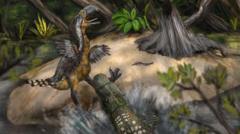In a thrilling discovery from Colombia's Tatacoa Desert, paleontologists have analyzed the vicious bites on a fossilized leg bone from a towering terror bird that roamed the Earth 13 million years ago. This stunning revelation points to a gruesome encounter with a formidable predator, likely an extinct caiman known as Purussaurus neivensis, which measured up to five meters in length.
Fossil hunter César Augusto Perdomo first unearthed this remarkable limb over 15 years ago, and recent analyses matched the teeth marks to those of the caiman. Scientists, led by Andres Link from the Universidad de Los Andes, believe this was a fierce "battle to the death." The leg bone's distinct puncture marks exhibit no healing signs, indicating this bird was likely killed during the attack rather than scavenged after death.
The researchers utilized advanced 3D scans to compare the bone's markings with museum specimens of similar predatory creatures. This new research sheds light on the ancient ecosystem, suggesting that terror birds, while known as apex predators, were not invulnerable.
Diving deeper into the findings, Dr. Link emphasized the significance of the fossil in piecing together the planet's history. Every fragment contributes to a vivid picture of how life was shaped in times long past, further fueling the excitement of paleontologists unearthing secrets from beneath the earth’s surface.



















